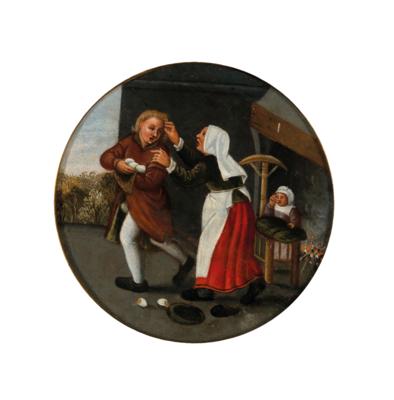Circle of Pieter Brueghel II

(Brussels 1564–1638 Antwerp)
A Flemish proverb, possibly ‘Hij legt ‘t ei in andermans nest’,
oil on panel, tondo, diameter 18 cm, framed
Provenance:
Private collection, Italy, until 2021
The present tondo is a testament to the enduring popularity of the folk-proverb genre so vividly developed and sustained by the Brueghel dynasty and their followers in Flanders throughout the sixteenth and early seventeenth centuries. The execution of the present work, and the pictorial format which apparently alludes to a Flemish saying, place it within the circle of Pieter Brueghel the Younger (1565–1636), whose prolific Antwerp workshop, with access to the artistic models of his late father Pieter Brueghel the Elder (circa 1525–1569), created several such tondi.
The iconography of the work is complex, as the proverbs that these works portrayed often had subtle double meanings. The hearth and crying child to the right, as well as the fallen cap with broken eggs beside it, are highly suggestive of the familial ‘nest’. This may pertain to the saying ‘Hij legt ‘t ei in andermans nest’ or ‘putting his egg in another man’s nest’ and could be perceived as a moralistic warning against infidelity. On the other hand, the obvious insinuation coming from the imploring mother on the right and the despondent child, along with the nest and egg symbolism, implies that the man on the left has impregnated the woman and is making a run for it.
Esperto: Damian Brenninkmeyer
 Damian Brenninkmeyer
Damian Brenninkmeyer
+43 1 515 60 403
oldmasters@dorotheum.com
11.05.2022 - 16:00
- Stima:
-
EUR 25.000,- a EUR 35.000,-
Circle of Pieter Brueghel II
(Brussels 1564–1638 Antwerp)
A Flemish proverb, possibly ‘Hij legt ‘t ei in andermans nest’,
oil on panel, tondo, diameter 18 cm, framed
Provenance:
Private collection, Italy, until 2021
The present tondo is a testament to the enduring popularity of the folk-proverb genre so vividly developed and sustained by the Brueghel dynasty and their followers in Flanders throughout the sixteenth and early seventeenth centuries. The execution of the present work, and the pictorial format which apparently alludes to a Flemish saying, place it within the circle of Pieter Brueghel the Younger (1565–1636), whose prolific Antwerp workshop, with access to the artistic models of his late father Pieter Brueghel the Elder (circa 1525–1569), created several such tondi.
The iconography of the work is complex, as the proverbs that these works portrayed often had subtle double meanings. The hearth and crying child to the right, as well as the fallen cap with broken eggs beside it, are highly suggestive of the familial ‘nest’. This may pertain to the saying ‘Hij legt ‘t ei in andermans nest’ or ‘putting his egg in another man’s nest’ and could be perceived as a moralistic warning against infidelity. On the other hand, the obvious insinuation coming from the imploring mother on the right and the despondent child, along with the nest and egg symbolism, implies that the man on the left has impregnated the woman and is making a run for it.
Esperto: Damian Brenninkmeyer
 Damian Brenninkmeyer
Damian Brenninkmeyer
+43 1 515 60 403
oldmasters@dorotheum.com
|
Hotline dell'acquirente
lun-ven: 10.00 - 17.00
old.masters@dorotheum.at +43 1 515 60 403 |
| Asta: | Dipinti antichi I |
| Tipo d'asta: | Asta in sala con Live Bidding |
| Data: | 11.05.2022 - 16:00 |
| Luogo dell'asta: | Wien | Palais Dorotheum |
| Esposizione: | 30.04. - 11.05.2022 |
